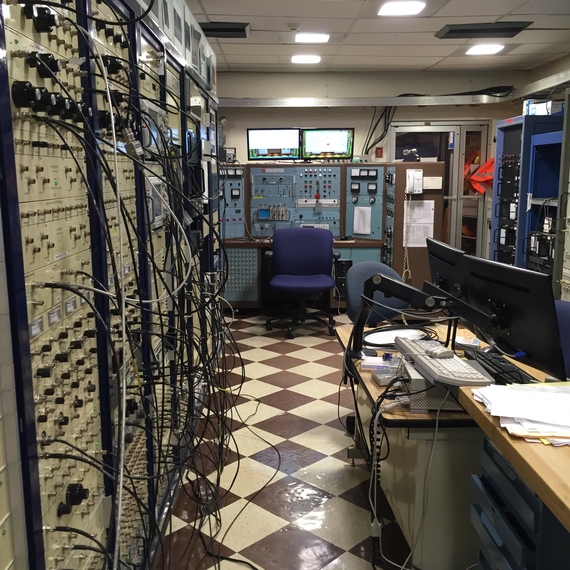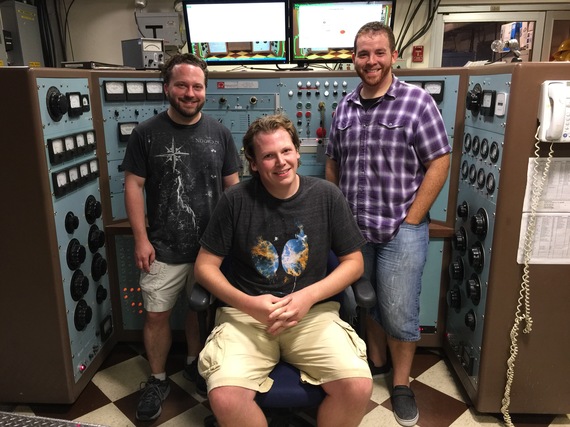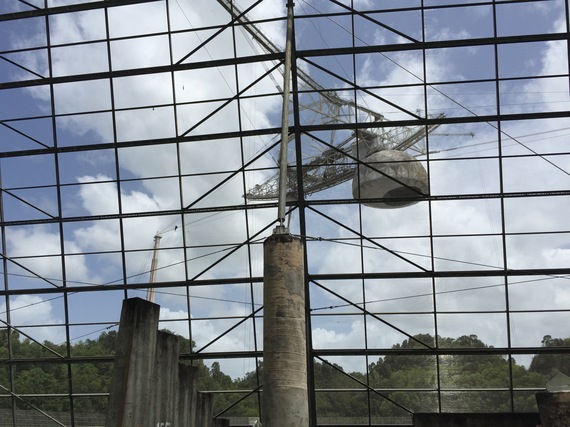Of the many reasons to visit Puerto Rico: tropical climate, Caribbean cuisine and Latin Music, only one is truly out of this world.
When Earthlings finally make contact with an intelligent alien civilization, odds are, the conversation will originate from Puerto Rico's historic Arecibo Observatory, the world's largest single-aperture telescope.
In the not too distant future, when some hero scientist discovers a giant meteor hurtling towards Earth (hopefully) BEFORE it delivers a fiery knock out punch to life as we know it, this is where they'll sound the alarm. When yet another smarty-pants surveys the signature wavelengths bouncing off a far away planet and confirms the presence of liquid water and oxygen similar to habitat here on Earth, these are the screens that will announce those momentous results.
This National Science Foundation radio telescope, located a mountainous 40-minute, mostly freeway drive, from downtown San Juan, is the same facility featured in the Jody Foster/Carl Sagan movie Contact. It's also the home for the SETI@home project, Earth's most organized and scientific crowd-sourced Search for Extra Terrestrial Intelligence. It is, quite simply, the super bowl of Space Exploration. And it looks like it.
Completed in 1963, the dish and its collectors are suspended by enormous grid wires strung across a natural bowl high in the mountains of northern Puerto Rico. The major update completed on the facility in 1974 has lead to many amazing space discoveries, including the Nobel Peace Prize winning discovery of the first binary pulsar by Hulse and Taylor. In 1989, the Observatory directly imaged an asteroid for the first time in history.
Even if you've seen photos of the telescope's radio dish, it's sheer size - 1000 fit across - must been experienced in person to appreciate. The bowl of the dish is made up of metal mesh, arrayed as a spherical reflector that collects radio waves from all over the universe and focuses them on the Gregorian Sub-Reflector suspended 500 feet above. The deluge of data streams across the gantry into the nearby control room where men and women with doctoral degrees, and kick ass Star Wars Halloween costumes, sift through the noise, listening and looking for... something. Anything; a coherent signal, a chemical signature - an "I'll know it when I see it" anomaly that in all probability would reward it's finder with a Nobel Prize.
Today, Arecibo is the focal point for the three major prongs of Earth's deep space research; Radio Astronomy, Atmospheric Science and Radar Astronomy. And you learn about all of it on your own tour.
Our tour was led by three of the leading space researchers working today, (l-r) Astronomy PhD Patrick Taylor, Andrew Seymour, the Physics Phd and Space & Planetary Science Phd Edgard Rivera-Valentin.
These guys, who look more like Ultimate Frisbee intramural players than the guys responsible for saving Earth from, well... everything we'd need saving from, took us on an amazing walking tour down into the ravine and under the dish.
They are each focused on their own speciality, actively teasing out the secrets of the Cosmos, much like Carl Sagan, the Cornell University professor who brought his wonder and excitement of space to the rest of us. Sagan was involved in the early history of Arecibo, which is one of the reasons the wonderful film CONTACT was shot on location here. Another is... there's no place else like it on Earth.
The Space Men took us on an hour-long tour of the facility and dish, and put up with far more stupid questions from me than they should have had to endure over a holiday weekend. The important take away, in layman's terms, is the rest of us are in good hands because these guys - and thousands of other men and women around the world working in similar fields - are crusading to squeeze amazingly esoteric truths from Terabytes of ones and zeroes. The kinds of truths that will one day, not maybe, but absolutely, save our planet.
Where do these uber-geniuses come from? The Dish. If you build it, they will come. Arecibo acts like a magnet, drawing in space nerds and crazy thinkers from all over the world to sit behind the wheel and study in its shadow.
On our walk they explained how Arecibo helps find new planets by their 'wobble,' new ways to spot NEO's [near Earth objects] before its too late, and nurture the next generation of scientists. Far as I could tell, they're Magna Cum Laude across the board.
After our tour with the current Wizards behind the curtain, we had an opportunity to talk with a group of high school kids during their summer residency at the dish. Normally, I am extremely cynical about 'these kids today.' But after spending an hour chatting with these kids inside a lab van during a tropical downpour, I'm convinced our future's so bright, I gotta wear shades.
Listen to their hilarious, and incredibly insightful conversation about the nature of science, humanity and the future of Earth itself on our Puerto Rico podcast, right here. And make sure you visit Arecibo during touring hours before you blast off back home. You'll never be the same.
Follow @MarkDeCarlo on Twitter to win travel prizes, get show and travel news and see our original travel videos. Listen to a new show every Thursday @ Orbitz





